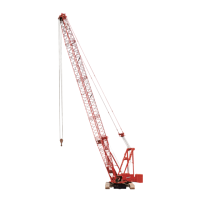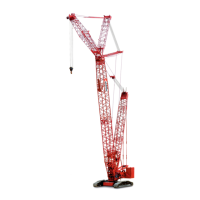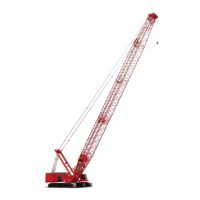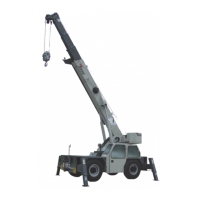Manitowoc Published 05-15-17, Control # 043-09 2-15
999 LUFFING JIB OPERATOR MANUAL SAFETY INFORMATION
Most overhead power lines ARE NOT insulated. Treat all
overhead power lines as being energized unless you
have reliable information to the contrary from the utility
company or owner.
The rules in this section must be followed at all times,
even if the electrical power lines or equipment have
been de-energized.
3. Crane operation is dangerous when close to an
energized electrical power source. Exercise extreme
caution and prudent judgment. Operate slowly and
cautiously when in the vicinity of power lines.
4. If the load, wire rope, boom, or any portion of the crane
contacts or comes too close to an electrical power
source, everyone in, on, and around the crane can be
seriously injured or killed.
The safest way to avoid electrocution is to stay away
from electrical power lines and electrical power sources.
5. The operator is responsible for alerting all personnel to
the dangers associated with electrical power lines and
equipment. The crane is not insulated. Do not allow
unnecessary personnel in the vicinity of the crane while
operating. Permit no one to lean against or touch the
crane. Permit no one, including riggers and load
handlers, to hold the load, load lines, taglines, or rigging
gear.
6. Even if the operator is not affected by an electrical
contact, others in the area may become seriously injured
or killed.
7. It is not always necessary to contact a power line or
power source to become electrocuted. Electricity,
depending on magnitude, can arc or jump to any part of
the load, load line, or crane boom if it comes too close to
an electrical power source. Low voltages can also be
dangerous.
Set-Up and Operation
1. During crane use, assume that every line is energized
(“hot” or “live”) and take necessary precautions.
2. Position the crane such that the load, boom, or any part
of the crane and its attachments cannot be moved to
within 20 ft (6 m) of electrical power lines or equipment.
This includes the crane boom and all attachments.
Overhead lines tend to blow in the wind, so allow for
movement of the overhead lines when determining a
safe operating distance.
3. Erect a suitable barricade to physically restrain the
crane, all attachments, and the load from entering into
an unsafe distance from electrical power lines or
equipment.
4. Plan ahead and always plan a safe route before
traveling under power lines. A wooden clearance frame
should be constructed to ensure sufficient clearance is
maintained between crane and power lines.
5. Appoint a reliable and qualified signal person, equipped
with a loud signal whistle or horn and voice
communication equipment, to warn the operator when
any part of the crane or load moves near a power
source. This person should have no other duties while
the crane is working.
6. Taglines should always be made of non-conductive
materials. Any tagline that is wet or dirty can conduct
electricity.
7. DO NOT store materials under power lines or close to
electrical power sources.
8. When operating near transmitter/communication towers
where an electrical charge can be induced into the crane
or load:
• The transmitter must be deenergized OR,
• Tests must be made to determine if an electrical
charge will be induced into the crane or load.
• The crane must be provided an electrical ground.
• If taglines are used, they must be non-conductive.
• Every precaution must be taken to dissipate
induced voltages. Consult with a qualified RF (radio
frequency) Consultant. Also refer to local, state, and
federal codes and regulations.
Electrocution Hazard Devices
1. The use of insulated links, insulated boom cages/
guards, proximity warning devices, or mechanical limit
stops does not ensure that electrical contact will not
occur. Even if codes or regulations require the use of
such devices, failure to follow the rules in this section
may result in serious injury or death.
2. Be aware that such devices have limitations and you
should follow the rules and precautions outlined in this
section at all times even if the crane is equipped with
these devices.
3. Insulating links installed into the load line afford limited
protection from electrocution hazards. Links are limited
in their lifting abilities, insulating properties, and other
properties that affect their performance. Moisture, dust,
dirt, oils, and other contaminants can cause a link to
conduct electricity. Due to their capacity ratings, some
links are not effective for large cranes and/or high
voltages/currents.
4. The only protection that may be afforded by an insulated
link is below the link (electrically downstream), provided
the link has been kept clean, free of contamination, has
not been scratched or damaged, and is periodically
tested (just before use) for its dielectric integrity.
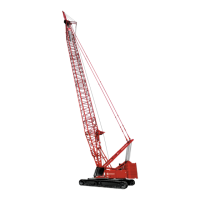
